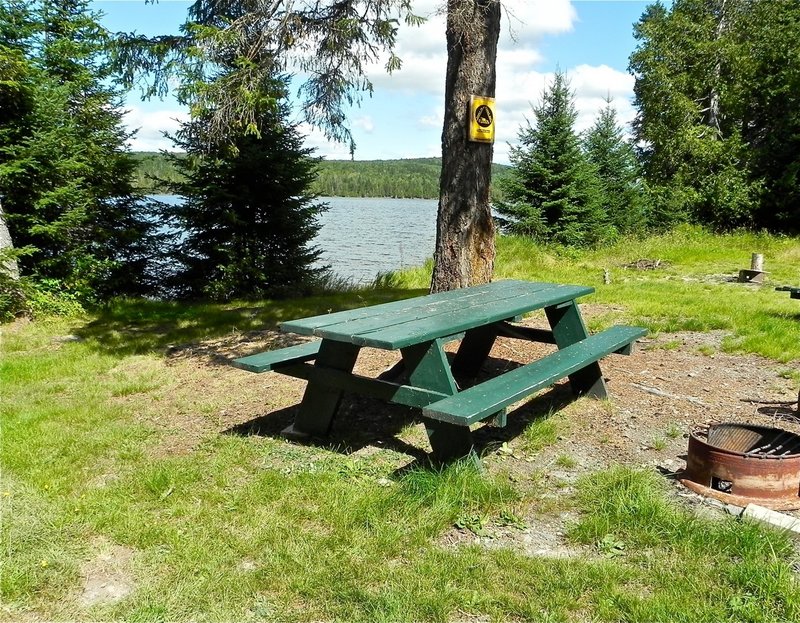July and August are great months for canoe adventures. If you want accessible remoteness, the region up around the headwaters of the Saint John River makes for a great escape.
No matter what driving route you select, it is a seven-hour drive from the Portland area. This makes a four-day window the minimum time needed: two days of driving, two days of paddling. Do one lake one day, select another the next day. Or stay the whole week and explore anew each day.
This month we are focusing on a four-hour, six-mile route around Saint Francis Lake. As the crow flies, we are 15 miles east of the Canadian border and nine miles east of Baker Lake, a popular starting point for canoeing the Saint John River in the spring. These vast timberlands are managed by the North Maine Woods organization for responsible recreational enjoyment. Fees are charged for entry and for camping at designated campsites on various lakes and waterways. Consult the DeLorme Maine Atlas and Gazetteer (maps 54 and 55) for help getting to Saint Francis Lake.
There is a secluded campsite on the southwestern end of Saint Francis Lake that gets very little use. At low water, you can walk along the shoreline over to a crescent-shaped beach on the western end of the lake. There are an amazing variety of colorful pebbles tossed up onto the sand. We always look for heart-shaped ones and added a few to our collection. Two large white pine lean out over the water, providing shade. The view down the lake is magnificent, with rounded hills creating a fjord-like look.
If you poke up over the thickly wooded berm behind the beach, you will emerge out into a classic dwarf shrub bog. Stunted black spruce and larch rise up out of a spongy carpet of peat moss and sedges. On our visit, the tufted cotton-grass was out. We had a great time taking pictures of the small white balls outlined against the northern sky. As we stood up and scanned the treetops, we saw a large broad-winged hawk gazing down at us from the top of a dead spruce.
During dry periods, you may on occasion see what looks like smoke rising in a line from the woods along the southern side of the lake. This is created by logging trucks passing by on the vast network of gravel logging roads in the area. Without the logging roads there is no easy access, so count the dust as a blessing.
At the outlet at the far end of the beach, the remains of an old logging road bridge remain. A few beaver dams downstream limit the flow of water. We contemplated seeing how far we could go down Saint Francis Stream but went with the easy route and decided to stay in the lake and in the canoe. This outlet area looks like fine moose viewing territory come evening, but we did not see any on our visit.
The lake is surrounded by an evergreen forest with more hardwoods mixed in along the southern shoreline. By mid-August you will start to see a preview of autumn, with a few maples turning a brilliant red out of a sea of green. Near the far end of the lake on the northern shoreline sits a traditional north woods log cabin, the only development on the lake. On the opposite shoreline sits another boat launch access point.
The eastern end of the lake is a great spot to hang out on a warm, sunny day. The cove is shallow and a hard-packed sandy bottom reaches far out into the lake. We had a wonderful time walking in bare feet in a foot of warm water, the ripples in the sand providing soothing massage therapy on our feet. We were amazed to see circular lines etched at various points on the cove floor. At the end of each piece of artwork a freshwater clam head stared up at us. We had never given much thought to if clams move around, how they do it and how fast.
At the mouth of the cove a pair of loons sat placidly, while overhead an osprey circled in search of fish. The northern edge of the cove has hundreds of spindly bleached white driftwood logs lined up together, some in the water, some straddling the shoreline, like a maze of pickup sticks created by persistent autumn gales.
At the end of the day, we drove the nine miles over to the outlet of Baker Lake to talk with the fishermen camped there. They had many tall tales to tell about the large muskies — the Maine State Record is nearly 27 pounds for this non-native species — that got away that day. One fellow had just returned from the long drive out to Millinocket to buy a new propeller to replace the one he had destroyed on one of the many boulders hidden in the shallows. Chalk another one up for the value of paddling a canoe.
Michael Perry is a former director of the L.L. Bean Outdoor Discovery Schools and founder of Dreams Unlimited, specializing in inspiring outdoor slide programs. He can be contacted at:
michaelj_perry@comcast.net
Send questions/comments to the editors.



Success. Please wait for the page to reload. If the page does not reload within 5 seconds, please refresh the page.
Enter your email and password to access comments.
Hi, to comment on stories you must . This profile is in addition to your subscription and website login.
Already have a commenting profile? .
Invalid username/password.
Please check your email to confirm and complete your registration.
Only subscribers are eligible to post comments. Please subscribe or login first for digital access. Here’s why.
Use the form below to reset your password. When you've submitted your account email, we will send an email with a reset code.